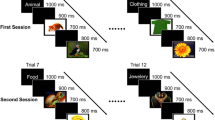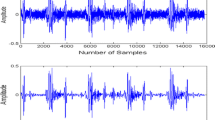Abstract
Signal discrimination contributes to the development of machine–machine and human–machine interactive intelligent systems. In this study, a novel framework for signal discrimination was proposed. The proposed framework comprised three phases. In Phase I, a waveform shape-based feature extraction method was used for parameterizing signals. In Phase II, a novel category-preserving bag-of-words (CPBoW) model was proposed. In Phase III, signals were discriminated using a vector space model with term frequency–inverse document frequency. The bag-of-words model generally demonstrated promising performance for signal discrimination. However, the inherent connections among signals of homogeneous categories were considerably lost during signal framing and codebook generation processes. This was because the codebook was simply generated by clustering signal frame samples in the Euclidean space. In the proposed CPBoW model, Taguchi’s quality engineering method was used to develop a category-preserving distance metric for executing a clustering process to generate category-preserving codewords. This preserved category information in the codebook and consequently increased the effectiveness of the discrimination process. The proposed framework was verified through three condition monitoring applications that involved a musical instrument recognition problem, motor bearing fault recognition problem, and heart disease recognition problem. The results indicated the superior performance and effectiveness of the proposed framework.






Similar content being viewed by others
References
Mukhopadhyay S, Biswas S, Roy AB, Dey N (2012) Wavelet based QRS complex detection of ECG signal. Int J Eng Res Appl 2(3):2361–2365
Bhalke DG, Rao CR, Bormane DS (2014) Hybridization of fractional fourier transform and acoustic features for musical instrument recognition. Int J Signal Process Image Process Pattern Recognit 7(1):275–282
Ebrahimzadeh A, Shakiba B, Khazaee A (2014) Detection of electrocardiogram signals using an efficient method. Appl Soft Comput 22:108–117
Yin J, Wang W, Man Z, Khoo S (2014) Statistical modeling of gear vibration signals and its application to detecting and diagnosing gear faults. Inf Sci 259:295–303
Teti R (2015) Advanced IT methods of signal processing and decision making for zero defect manufacturing in machining. Procedia CIRP 28:3–15
Bhalke DG, Rao CR, Bormane DS (2016) Automatic musical instrument classification using fractional fourier transform based-MFCC features and counter propagation neural network. J Intell Inf Syst 46(3):425–446
Wang D (2016) K-nearest neighbors based methods for identification of different gear crack levels under different motor speeds and loads: revisited. Mech Syst Signal Process 70:201–208
Pławiak P (2018) Novel methodology of cardiac health recognition based on ECG signals and evolutionary-neural system. Expert Syst Appl 92:334–349
Chatterjee S, Dey N, Shi F, Ashour AS, Fong SJ, Sen S (2018) Clinical application of modified bag-of-features coupled with hybrid neural-based classifier in dengue fever classification using gene expression data. Med Biol Eng Compu 56:709–720
Hsiao YH, Su CT (2009) Multi-class MTS for saxophone timbre quality inspection using waveform shape-based features. IEEE Trans Syst Man Cybern B Cybern 39(3):690–704
Pons-Llinares J, Antonino-Daviu J, Riera-Guasp M, Lee S, Kang TJ, Yang C (2015) Advanced induction motor rotor fault diagnosis via continuous and discrete time–frequency tools. IEEE Trans Industr Electron 62(3):1791–1802
Goyal D, Pabla BS (2016) The vibration monitoring methods and signal processing techniques for structural health monitoring: a review. Arch Comput Methods Eng 23(4):585–594
Chauhan S, Wang P, Sing Lim C, Anantharaman V (2008) A computer-aided MFCC-based HMM system for automatic auscultation. Comput Biol Med 38(2):221–233
Fu Z, Lu G, Ting KM, Zhang D (2011) Music classification via the bag-of-features approach. Pattern Recognit Lett 32(14):1768–1777
Zokaee S, Faez K (2012) Human identification based on ECG and palmprint. Int J Electr Comput Eng 2(2):261–266
Schmitt M, Ringeval F, Schuller BW (2016) At the border of acoustics and linguistics: bag-of-audio-words for the recognition of emotions in speech. In: Interspeech, pp 495–499
Proakis JG, Manolakis DG (2006) Digital signal processing: principles, algorithms, and applications. Prentice Hall, Englewood Cliffs
Lee CH, Shih JL, Yu KM, Lin HS (2009) Automatic music genre classification based on modulation spectral analysis of spectral and cepstral features. IEEE Trans Multimed 11(4):670–682
Morvidone M, Sturm BL, Daudet L (2010) Incorporating scale information with cepstral features: experiments on musical instrument recognition. Pattern Recognit Lett 31(12):1489–1497
Peeters G (2011) Spectral and temporal periodicity representations of rhythm for the automatic classification of music audio signal. IEEE Trans Audio Speech Lang Process 19(5):1242–1252
Engin M (2004) ECG beat classification using neuro-fuzzy network. Pattern Recognit Lett 25(15):1715–1722
Zheng J, Pan H, Cheng J (2017) Rolling bearing fault detection and diagnosis based on composite multiscale fuzzy entropy and ensemble support vector machines. Mech Syst Signal Process 85:746–759
Wang C, Huang K (2015) How to use bag-of-words model better for image classification. Image Vis Comput 38:65–74
Qin J, Yung NHC (2010) Scene categorization via contextual visual words. Pattern Recognit 43(5):1874–1888
Li T, Mei T, Kweon I-S, Hua X-S (2011) Contextual bag-of-words for visual categorization. IEEE Trans Circuits Syst Video Technol 21(4):381–392
Passalis N, Tefas A (2016) Entropy optimized feature-based bag-of-words representation for information retrieval. IEEE Trans Knowl Data Eng 28(7):1664–1677
Dimitrovski I, Kocev D, Loskovska S, Džeroski S (2016) Improving bag-of-visual-words image retrieval with predictive clustering trees. Inf Sci 329:851–865
Beagum S, Ashour A, Dey N (2016) Bag-of features in microscopic images classification. In: Dey N, Ashour A (eds) Classification and clustering in biomedical signal processing. IGI Global, Hershey, pp 1–22
Passalis N, Tefas A (2017) Learning neural bag-of-features for large-scale image retrieval. IEEE Trans Syst Man Cybern Syst 47(10):2641–2652
Lin J, Li Y (2009) Finding structural similarity in time series data using bag-of-patterns representation. In: International conference on scientific and statistical database management, pp 461–477
González LC, Moreno R, Escalante HJ, Martínez F, Carlos MR (2017) Learning roadway surface disruption patterns using the bag of words representation. IEEE Trans Intell Transp Syst 18(11):2916–2928
Zhao J, Itti L (2016) Classifying time series using local descriptors with hybrid sampling. IEEE Trans Knowl Data Eng 28(3):623–637
Tsui KL (1992) An overview of Taguchi method and newly developed statistical methods for robust design. IIE Trans 24(5):44–57
Taguchi G, Chowdhury S, Wu Y (2005) Taguchi’s quality engineering handbook. Wiley, Hoboken
Singhal A (2001) Modern information retrieval: a brief overview. Bull IEEE Comput Soc Tech Comm Data Eng 24(4):35–43
Zhang H, Chow TW, Wu QJ (2016) Organizing books and authors by multilayer SOM. IEEE Trans Neural Netw Learn Syst 27(12):2537–2550
Burden RL, Faires JD (2000) Numerical analysis, 7th Bk&Cdr ed. Brooks/Cole, Boston
Pham DT, Dimov SS, Nguyen CD (2005) Selection of K in K-means clustering. J Mech Eng Sci 219(1):103–119
Huang A (2008) Similarity measures for text document clustering. In: Proceedings of the sixth New Zealand computer science research student conference, pp 49–56
Seshadrinath J, Singh B, Panigrahi BK (2014) Vibration analysis based interturn fault diagnosis in induction machines. IEEE Trans Ind Inf 10(1):340–350
Rauber TW, de Assis Boldt F, Varejão FM (2015) Heterogeneous feature models and feature selection applied to bearing fault diagnosis. IEEE Trans Ind Electron 62(1):637–646
Sharma A, Amarnath M, Kankar PK (2016) Feature extraction and fault severity classification in ball bearings. J Vib Control 22(1):176–192
Goldberger AL, Amaral LAN, Glass L, Hausdorff JM, Ivanov PCh, Mark RG, Mietus JE, Moody GB, Peng CK, Stanley HE (2000) PhysioBank, PhysioToolkit, and PhysioNet: components of a new research resource for complex physiologic signals. Circulation 101(23):e215–e220
Slaney M (1998) Auditory toolbox. Software retrieved August 13, 2017, from http://cobweb.ecn.purdue.edu/~malcolm/interval/1998-010/
Chang CC, Lin CJ (2001) LIBSVM: a library for support vector machines, 2001. Software Retrieved January 21, 2017, from http://www.csie.ntu.edu.tw/~cjlin/libsvm
University of Iowa Musical Instrument Sample Database. http://theremin.music.uiowa.edu/index.html
Loparo KA (2013) Bearing Data Center, Case Western Reserve University. http://csegroups.case.edu/bearingdatacenter/pages/welcome-case-western-reserve-university-bearing-data-center-website. Accessed 6 Mar 2016
Zhang S, Li W (2014) Bearing condition recognition and degradation assessment under varying running conditions using NPE and SOM. Math Problems Eng Vol. 2014, Article ID 781583
Moody GB, Mark RG (2001) The impact of the MIT-BIH arrhythmia database. IEEE Eng Med Biol Mag 20(3):45–50
Su CT, Hsiao YH (2007) An evaluation of the robustness of MTS for imbalanced data. IEEE Trans Knowl Data Eng 19(10):1321–1332
Acknowledgements
This study was supported by the Ministry of Science and Technology of Taiwan (Grant No. NSC 102-2410-H-305-062).
Author information
Authors and Affiliations
Corresponding author
Ethics declarations
Conflict of interest
The author declares that he has no conflict of interest.
Rights and permissions
About this article
Cite this article
Hsiao, YH. Signal discrimination using category-preserving bag-of-words model for condition monitoring. Neural Comput & Applic 31, 8615–8630 (2019). https://doi.org/10.1007/s00521-018-3799-0
Received:
Accepted:
Published:
Issue Date:
DOI: https://doi.org/10.1007/s00521-018-3799-0




